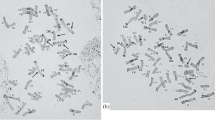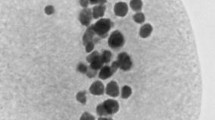Summary
Meiosis was studied in some triploid, tetraploid and hexaploid F1-hybrids from Solanum acaule x S. bulbocastanum and in a triploid F1-hybrid from S. acaule x S. tuberosum-haploid.
The only anomaly found was stickiness at metaphase I, the degree of which appeared to be related to the proportion of the S. bulbocastanum chromosomes in the hybrids. No stickiness occurred at pre- and post-metaphase stages.
A clear allosyndetic pairing between chromosomes of the two S. acaule genomes was observed in all triploid and tetraploid hybrids. These genomes apparently are closely related and little differentiated. The triploids S. acaule x S. bulbocastanum had 0–1 trivalent per cell, whereas 2–5 trivalents per cell were observed in the triploid S. acaule x S. tuberosum-haploid. Therefore S. acaule is more closely related to S. tuberosum L. than to S. bulbocastanum. A small amount of pairing between S. acaule and S. bulbocastanum is apparent from the occurrence of multivalents in all hybrids.
Hexaploid F1's (2n=72) showed a nearly complete homologous pairing of chromosomes (35.2 bivalents per cell) and generally a normal separation of chromosomes at anaphase: 36-36. This offers an explanation for their high fertility. Triploid F1's from S. acaule x S. bulbocastanum have a high frequency of univalents leading to irregular separation of chromosomes at anaphase and consequently to unbalanced gametes and extreme sterility. In the tetraploid F1's (2n=48) nearly complete bivalent pairing was observed, 50% expectedly being homologous and 50% homoeologous pairing. Separation of chromosomes at anaphase was generally normal 24-24. In spite of this normal behaviour and allowing for tight stickiness at metaphase the tetraploids are very sterile. A satisfactory explanation cannot yet be given.
Selfing and intercrossing hexaploid F1's gives normal berry set and many seeds per berry. However crosses with S. tuberosum and even those with the fertile hexaploid hybrid from 8x-S. acaule x 4x-S. tuberosum are little successful: berry set is far below normal and the berries are either parthenocarpic or contain only one or two seeds. These rather unexpected results warrant further investigation. Large-scale selfings and intercrosses of triploid and tetraploid hybrids have not been successful as yet. Among the female gametes of tetraploid hybrids a few appeared to be functional in crosses with hexaploid hybrids and in those with S. bulbocastanum.
Similar content being viewed by others
References
Bains, G. S., 1951. Cytogenetical studies in the genus Solanum Sect. Tuberarium. M.Sc. dissertation, Univ. Cambridge.
Dionne, L. A., 1963. Studies on the use of Solanum acaule as a bridge between Solanum tuberosum and species in the Series Bulbocastana, Cardiophylla and Pinnatisecta. Euphytica 12: 263–269.
Dionne, L. A., 1966. Research report of the Research Station Frederiction, New Brunswick, Canada, 1965–1966: 13–14.
Dionne, L. A., and Hodgson, W. A., 1966. Advances in potato late blight resistance. Can. Agric. 2: 28–29.
Graham, K. M., Niederhauser, J. S. and Servin, L., 1959. Studies on fertility and late blight resistance in Solanum bulbocastanum Dun. in Mexico. Can. J. Botany 37: 41–49.
Hawkes, J. G., 1958. Taxonomy, cytology and crossability (of potatoes). In: H. Kappert and W. Rudorf: Handbuch der Pflanzenzüchtung. 2nd ed., pp. 1–43.
Hermsen, J. G. Th., 1966. Crossability, fertility and cytogenetic studies in Solanum acaule x Solanum bulbocastanum. Euphytica 15: 149–155.
Lebedeva, N. A., 1966. Solanum bulbocastanum Dun. — A promising species for potato selection. Soviet Genetics 2: 47–50.
Livermore, J. R. and Johnstone, F. B., 1940. The effect of chromosome doubling on the crossability of S. chacoense, S. jamesii and S. bulbocastanum with S. tuberosum. Am. Potato J. 17: 170–173.
Matsubayashi, M., 1961. Cytogenetic studies in Solanum, Section Tuberarium, with special reference to the interspecific relationships. Diss. Kyoto University, pp. 121.
Propach, H., 1937. Cytogenetische Untersuchungen in der Gattung Solanum, Sect. Tuberarium. II. Triploide und tetraploide Artbastarde Z. indukt. Abstamm. Vererb. Lehre 73: 143–154.
Reddick, D., 1930. Frost-tolerant and blight-resistant potatoes. Phytopathology 20: 987–992.
Swaminathan, M. S., 1954. Nature of ploidy in some 48-chromosome species of the genus Solanum, Sect. Tuberarium. Genetics 39: 59–76.
Swaminathan, M. S., Magoon, M. L. and Mehra, K. L., 1954. A simple propiono-carmine PMC smear method for plants with small chromosomes. Indian J. Genet. 14: 87–88.
Author information
Authors and Affiliations
Rights and permissions
About this article
Cite this article
Hermsen, J.G.T., Ramanna, M.S. Meiosis in different F1-hybrids of Solanum acaule Bitt. x S. bulbocastanum Dun. and its bearing on genome relationship, fertility and breeding behaviour. Euphytica 18, 27–35 (1969). https://doi.org/10.1007/BF00021979
Received:
Issue Date:
DOI: https://doi.org/10.1007/BF00021979




